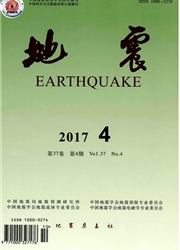

 中文摘要:
中文摘要:
东昆仑断裂带作为青藏高原中东部的巴颜喀拉地块北缘边界断裂带,研究其强震破裂行为对于认识断裂带活动性及分析川西北地区未来地震危险性具有重要意义。通过沿断裂发育的大量断错地貌勘查、典型微地貌DGPS测量及样品年代测定,认为东昆仑断裂带向东的强震活动性延伸至若尔盖盆地北侧,即东昆仑断裂带东部塔藏断裂的罗叉段。此段在卫星影像上呈清晰的灰黑色、灰黄色线性条带,地震形变带主要表现为断层陡坎、坡中谷、冲沟和阶地位错、植物异常呈线性分布、跌水、断层泉、断塞塘以及伴随地表错动而出现的滑坡、垮塌和倒石堆。这些破裂现象沿先存断层断续分布,组成长约50km的“L”形地震形变带。断裂活动造成冲沟和阶地左行运动,位错量主要集中在5.5~6.0m、18~23m、68--75m和200-220m范围。最近地震发生在(340±30)~(500±30)BP间,宏观震中位于本多村西北5~7km,震级为MW7.3左右,同震位移最大值为6m,水平位错量为5.5~6.0m,垂直位错量一般为0.2~0.5m,其比例为5:1~10:1。对地震形变带中的各种变形遗迹和地震地表破裂特征的研究表明,塔藏断裂是这次地震的发震构造。确定了塔藏断裂为全新世活动断层,近期断层在压剪切作用控制下以左行运动为主,兼有少量逆冲分量,同东昆仑断裂带其他段的活动性质相似,认为东昆仑断裂带延伸至若尔盖盆地北侧,研究结果支持“大陆逃逸”模型。
 英文摘要:
英文摘要:
The East Kunlun fault zones are located in the northern margin of the Bayanhar block. Investigation of earthquake rupture behaviors of these fault zones is helpful for future seismic risk estimation for northwest Sichuan. We carried out a number of field geological investigation, typical micro-topography DGPS measurement and sample dating. Our results show that earthquake activities of the East Kunlun fault zones extend to the north bound of the Zoige basin. This part has been named Luocha segment, which belonged to the Tazang fault. Satellite images for Luocha segment are clear on the gray strips. The earthquake rupture zones are represented mainly by fault scarp, slope in the valley, gully and terraces dislocation, plant distribution in linear, plunge, fault springs, broken plug pond, landslide, collapsed and talus. These phenomena are distributed along the fault and formed an -50 km long inverse "L-shaped" deformation strip. Fault activities produced gullies and left movement of terraces. Horizontal dislocations are in the range of 5.5-6 m, 18-23 m, 68-75 m, 200-220 m respectively. An earthquake hap- pened recently between 340±30-500±30 BP, its macro-epicenter was located 5-7 kms northwest from the Benduo village, magnitude Mw 7. 3-7.4, with a maximum of 6 m coseismic displacement, horizontal dislocation 5.5-6 m, vertical dislocation 0.2-0.5 m. These phenomena show that the Tazang fault was the causative fault of the earthquake and raptured in Holocene. The fault has been controlled by compressive shear recently and shows horizontal movement with slight thrust components, similar to other segments of the East Kunlun fault zones. The results supports the "mainland escape" model.
 同期刊论文项目
同期刊论文项目
 同项目期刊论文
同项目期刊论文
 期刊信息
期刊信息
